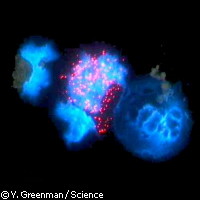EU-funded researchers use gene therapy to slow brain disease
The brain disease X-linked adrenoleukodystrophy (ALD) can be treated with a combination of gene therapy and blood stem cell therapy, new EU-funded research shows. The research is part of the X-ALD ('X-linked adrenoleukodystrophy: pathogenesis, animal models and therapy') project, which received EUR 1.8 million under the 'Life sciences, genomics and biotechnology for health' Thematic area of the EU's Sixth Framework Programme (FP6). The study's findings were published in the journal Science. X-ALD is the most common monogenic disorder affecting the myelin (the protective layer that coats the nerves). Ultimately the myelin sheath that surrounds the nerves is destroyed causing neurologic problems. Patients who have no myelin succumb to mental and physical problems triggered by nerves that lose their function. Adult males from 20 to 50 years of age, adult women over 40 years and boys between 5 and 12 years are affected. Neurological abnormalities, frequently in combination with impaired adrenal function, characterise this disease; the most severe variant results in death within 2 to 4 years after symptom onset. The international team of researchers from France, Germany and the US evaluated two patients in a two-year pilot study. They successfully slowed the progression of ALD by using a lentiviral vector to introduce a therapeutic gene into the blood cells of the patients. While the researchers recognise the need for studies with larger groups of patients to be conducted, these results indicate that gene therapy with lentiviral vectors may play a central role in the treatment of human disorders. 'This is the first time we were able to successfully use an HIV-derived lentivirus vector for gene therapy in humans, and also the first time that a very severe brain disease has been treated with efficacy by gene therapy,' explained co-author Professor Patrick Aubourg of Université Paris Descartes in France, and the head of a research unit at INSERM, Université Paris Descartes. While bone marrow transplants can slow down the progression of X-ALD, success in actually finding a matching bone marrow donor is very difficult and the transplants are not without risks. In this study, the researchers determined that genetically correcting the blood stem cells in patients' own bone marrow may actually help patients survive, particularly when no matched donors are found. The majority of gene therapy studies that have been carried out used a working gene that was inserted into the genome to replace a disease-causing gene. A vector (a carrier molecule that is considered the backbone of viruses that have been genetically altered to carry normal DNA) delivers the therapeutic gene into the cells of patients. Recent studies have shown how vectors based on the lentivirus genus of retroviruses are being used by researchers, who say lentiviral vectors have the ability to infect both dividing and non-dividing cells. Researchers also speculate that they offer stable and long-term gene expression. 'The HIV-derived lentivirus vector allows expression of the therapeutic gene in principle for life, because the therapeutic gene is inserted in the chromosomes - the genome,' Professor Aubourg said. 'Therefore, cells that derive from the initially corrected cells, stem cells in particular, will continue to express the therapeutic gene forever.' By using a lentiviral vector in this study, the researchers successfully removed the patients' blood stem cells and genetically corrected them in the lab. They introduced a working copy of the ALD gene into the cells. The researchers then infused the altered cells back into the patients following treatment that damaged their bone marrow. After two years, the researchers detected ALD proteins in the patients' blood cells. Neurological improvement was noted, and the progression of the disease was similar to that found with bone marrow transplants. According to the team, the healthy ALD protein was expressed in about 15% of blood cells. 'This percentage of correction will not be sufficient for all diseases,' Professor Aubourg pointed out. 'There is a lot of work to be done to make this gene therapy vector more powerful, less complicated and less expensive. This is only the beginning.' The X-ALD consortium consisted of six partners from Germany, Spain, France and the Netherlands.



